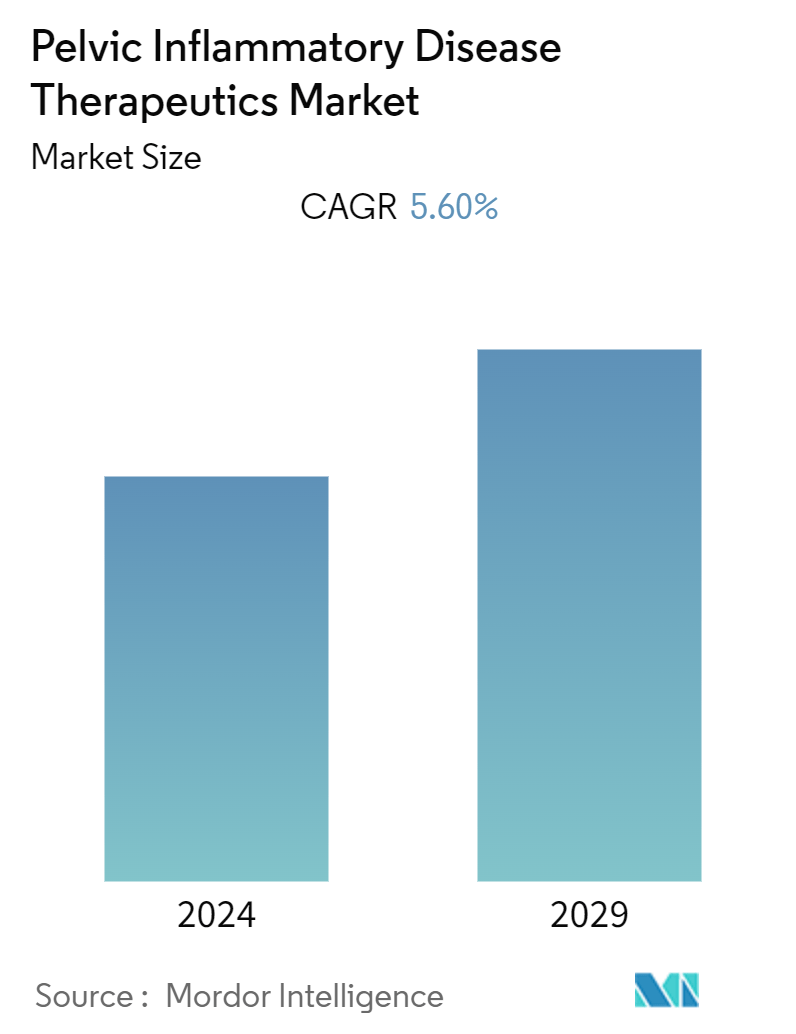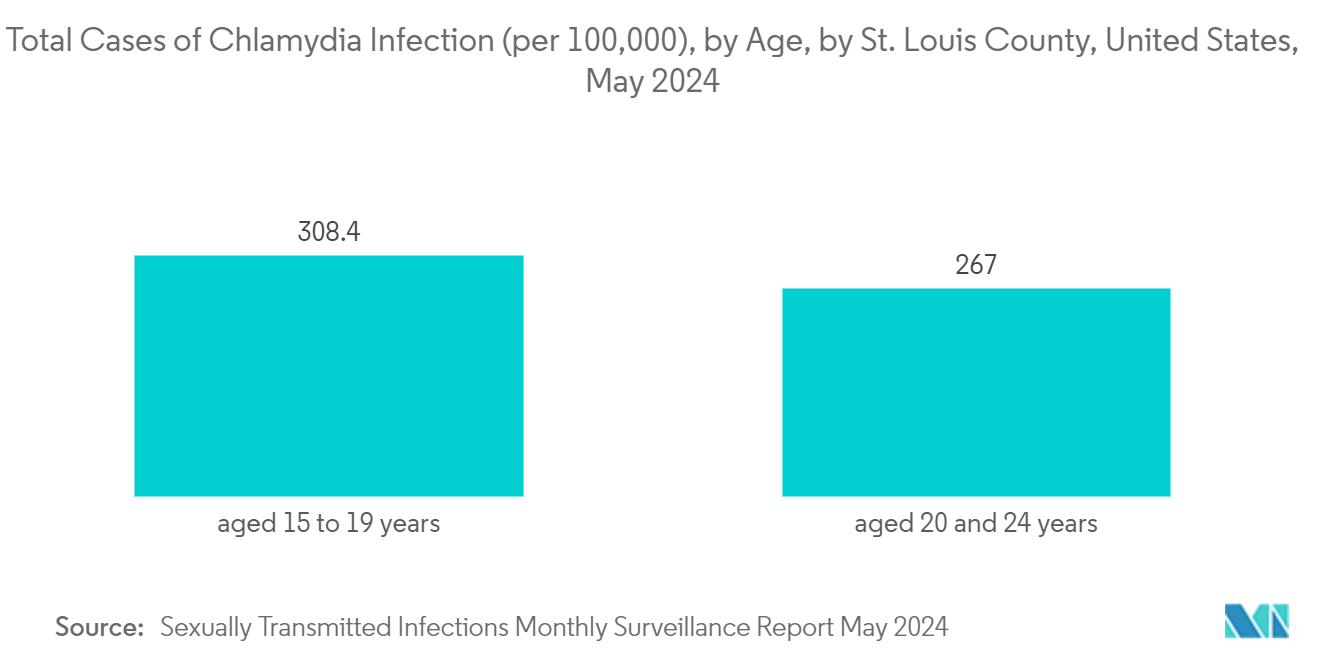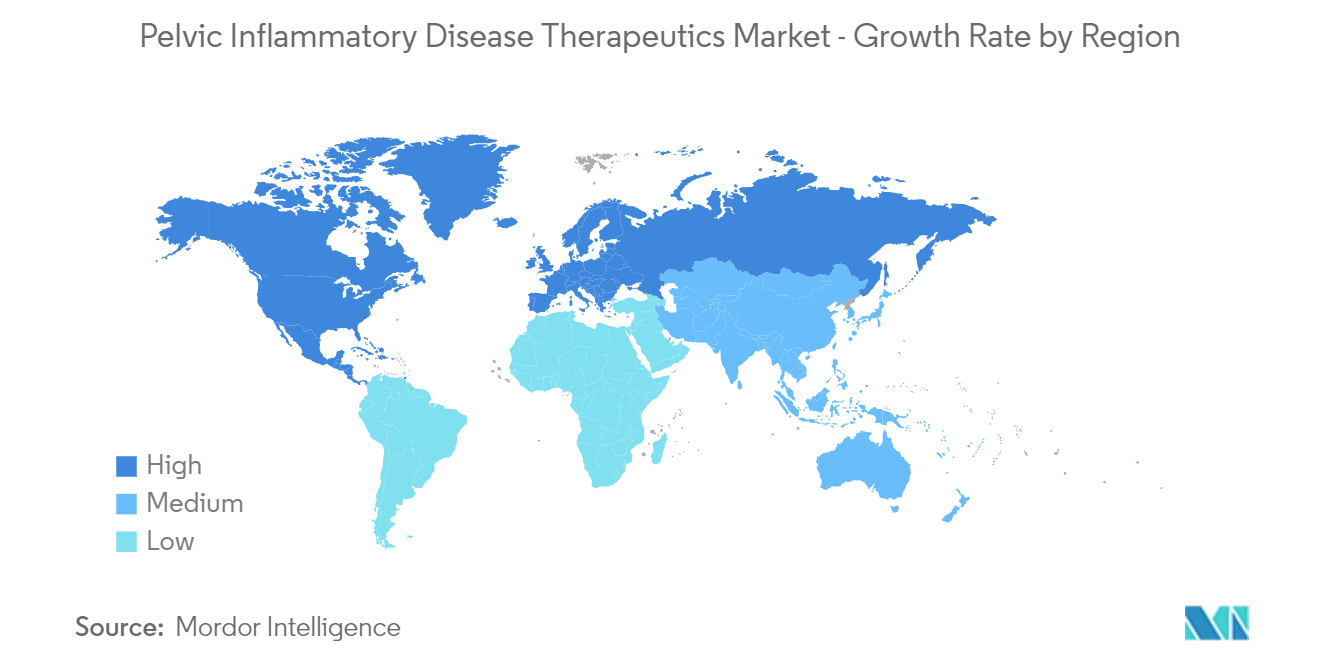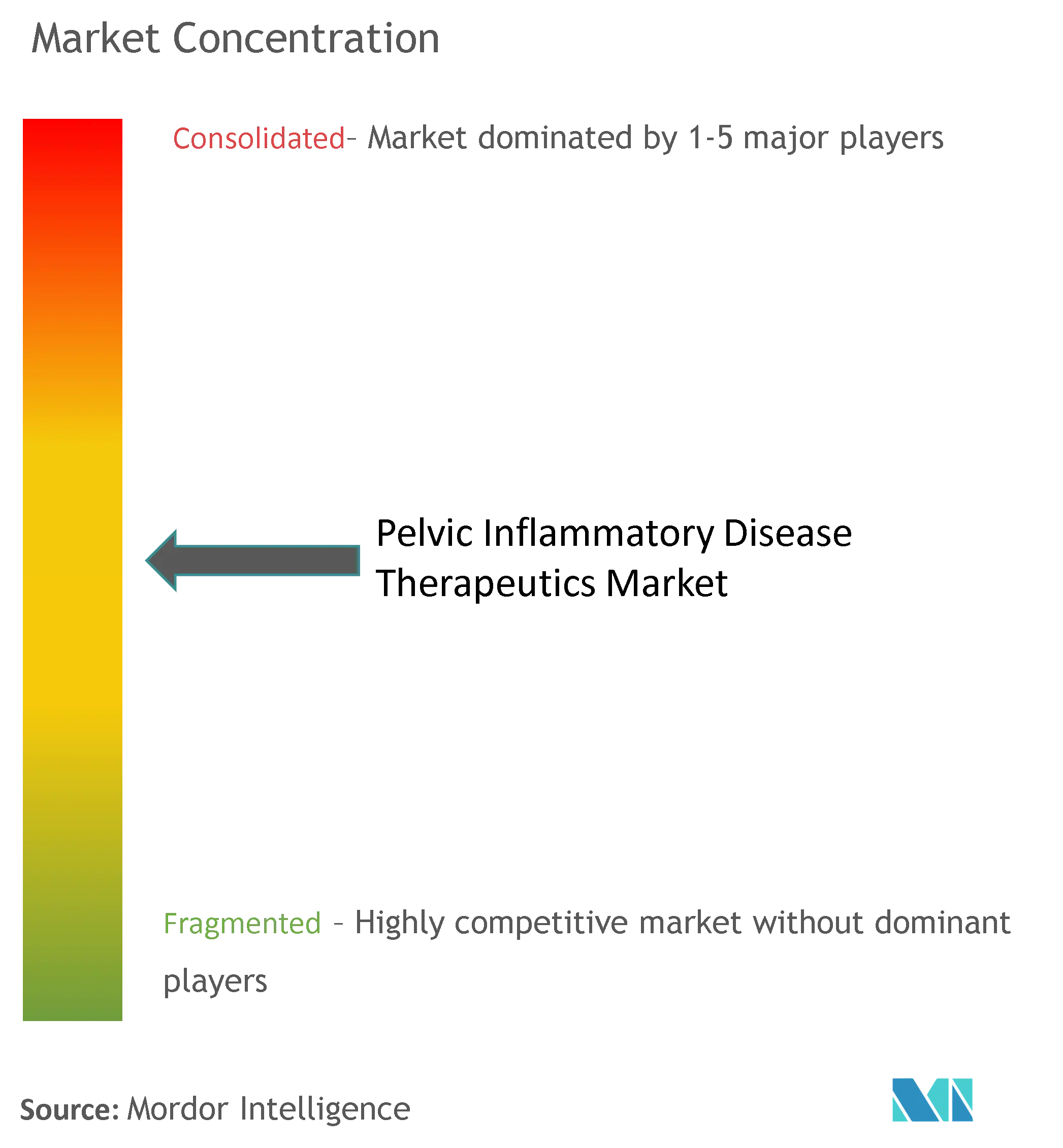Pelvic Inflammatory Disease Therapeutics Market Size

| Study Period | 2019 - 2029 |
| Base Year For Estimation | 2023 |
| CAGR (2024 - 2029) | 5.60 % |
| Fastest Growing Market | Asia Pacific |
| Largest Market | North America |
| Market Concentration | Medium |
Major Players
*Disclaimer: Major Players sorted in no particular order |
Pelvic Inflammatory Disease Therapeutics Market Analysis
The Pelvic Inflammatory Disease Therapeutics Market is expected to register a CAGR of 5.60% during the forecast period.
Factors such as the increasing prevalence of sexually transmitted diseases (STDs) and infections worldwide and the rise in healthcare awareness, along with the increasingly aging female population, are expected to boost the market’s growth during the forecast period.
The growing burden of sexually transmitted diseases (STDs) among the population globally, owing to having unprotected sex, is the key factor propelling market growth. For instance, in October 2023, the UK Health Security Agency (UKHSA) released data on sexually transmitted infections (STIs) and the chlamydia screening program. The data highlighted significant increases in diagnoses, with 392,453 new STIs, notably gonorrhea and syphilis, in 2022, with an increase of 23.8% compared to the previous year. Gonorrhea diagnoses increased to 82,592 in 2022, an increase of 50.3% compared to 54,961 cases diagnosed during the last year in England. Thus, the rising number of infectious cases among the population raises their risk of developing pelvic inflammatory diseases, fueling the demand for effective therapeutics and boosting market growth.
Similarly, preliminary National Institute of Infectious Diseases (NIID) 2023 data showed that the number of people infected with STDs hit a total of 4,370 as of April 2023. This figure greatly exceeded the 3,027 infections recorded during the same period in 2022. Thus, the increasing number of STDs, such as chlamydia and gonorrhea, can cause pelvic inflammatory diseases as they cause inflammation and infection in the pelvic organs. Hence, the demand for novel therapeutics is expected to be bolstered, propelling market growth.
Furthermore, growing government initiatives to launch various awareness programs and guidelines regarding STDs and infections related to pelvic organs raise diagnosis and screening of the condition. This is further expected to create opportunities for the high demand for effective therapeutics, augmenting the market’s growth. For instance, in June 2022, the Centers for Disease Control and Prevention recommended and released guidelines for screening sexually transmitted diseases (STDs). These guidelines aim to raise awareness about the growing global burden of STDs and the importance of screening programs. The recommendations are tailored, with specific guidelines for various demographic groups, including women, pregnant women, men who have sex with women, men who have sex with men, transgender and gender-diverse individuals, and those with HIV.
Similarly, in March 2022, the State of New Jersey's Department of Health launched the Sexually Transmitted Disease (STD) Program. The initiative aimed to combat and mitigate the repercussions of STDs in New Jersey through partner services, education, technical support, surveillance, and collaborations with local health and community entities. By enhancing disease awareness and treatment knowledge, these efforts are poised to drive the demand for PID therapeutics, thus bolstering the market’s growth during the forecast period.
Therefore, the high burden of STDs and infections among the population and growing government initiatives are expected to fuel the market’s growth during the forecast period. However, the stringent regulatory framework that delays the approval of products, expensive patented products, and severe complications associated with the medication are expected to hinder the growth of the pelvic inflammatory disease therapeutics market during the forecast period.
Pelvic Inflammatory Disease Therapeutics Market Trends
Tetracyclines Segment is Expected to Register Significant Growth in the Pelvic Inflammatory Disease Therapeutics Market During the Forecast Period
- Tetracycline, along with other drugs such as doxycycline and azithromycin, is used to treat pelvic inflammatory diseases as it works by inhibiting bacterial protein synthesis, thus preventing bacteria from multiplying and causing further infection.
- Tetracycline drugs are expected to dominate the industry during the forecast period. The lucrative growth of the segment can be attributed to the rise in the adoption of novel drugs due to proven efficiency in the treatment of bacterial infections and the rising number of clinical studies by the companies that fuel the availability of novel drugs in the market.
- Additionally, a growing number of research studies related to the safety and efficacy of tetracyclines in treating pelvic inflammatory diseases is expected to boost their adoption among the target patients, boosting segment growth.
- Various research studies were conducted to determine the safety, efficacy, and clinical utility of the three generations of tetracycline-class drugs. For instance, an article published by the Annals of Medicine in June 2022 highlighted adequate safety records and a broad spectrum of activity, making tetracycline-class antibiotics a preferred choice for treating diverse bacterial infections. In addition, the newest generation, featuring drugs like eravacycline, tigecycline, and omadacycline, effectively counteracts the most prevalent tetracycline resistance mechanisms. Thus, the high safety and efficacy of tetracycline antibiotics are anticipated to increase their adoption in the treatment of various pelvic infections, boosting segment growth.
- Similarly, the findings from the 2022 International AIDS Conference revealed that doxycycline reduced the risk of contracting chlamydia by 74% and syphilis by 77% among individuals living with HIV. Furthermore, an article published by the New England Journal of Medicine stated that among men who have sex with men (MSM) and transgender women, taking the oral antibiotic doxycycline within 72 hours of condomless sex prevented the contraction of sexually transmitted infections (STIs). Hence, the efficacy of tetracycline in reducing bacterial infections is anticipated to fuel the demand for such drugs in the market, propelling segment growth.
- Furthermore, the rising number of clinical trials conducted by companies and institutes accelerates the development of novel therapeutics for the treatment of pelvic disease, thereby bolstering segment growth. For instance, in February 2024, the National Institute of Allergy and Infectious Diseases (NIAID) conducted a Phase IV study to compare the efficacy of a three-day vs. seven-day regimen of doxycycline for the treatment of urogenital chlamydia (CT) infection among the population in the United States and Kenya.
- Therefore, owing to factors such as rising clinical and research studies related to oral antibiotics, the segment is anticipated to witness significant growth during the forecast period.

North America is Expected to Hold Significant Market Share During the Forecast Period
- North America is expected to witness a significant market share during the forecast period owing to factors such as the increasing pelvic organ diseases, rising cases of sexually transmitted infections owing to the adoption of unprotected sex, rising healthcare awareness regarding infectious diseases, and the growing aging population. In addition, increasing government initiatives and new product launches by companies are expected to boost the market’s growth during the forecast period.
- The market is poised for growth, driven by a surge in sexually transmitted infections, a consequence of increasing instances of unprotected sex. For instance, as per a Sexually Transmitted Infections Monthly Surveillance Report published in May 2024, about 503 cases of chlamydia (50.2 cases per 100,000 population), 175 cases of gonorrhea (17.5 cases per 100,000), and 11 cases of early syphilis (1.1 cases per 100,000) were diagnosed among St. Louis County residents, United States. In addition, St. Louis County residents were diagnosed with 175 Neisseria gonorrhoeae infections in May 2024, resulting in an incidence rate of 17.5 cases per 100,000 residents.
- Similarly, in April 2023, a report published by the Centers for Disease Control and Prevention (CDC) stated that STDs remain a significant public health concern in the United States. Thus, the burden of STDs leads to the development of infection and inflammation in the pelvic organs, further raising the risk of developing PID. This is expected to boost the demand for PID therapeutics across the region, bolstering market growth.
- Furthermore, as governments increasingly set guidelines for the use of doxycycline antibiotics, particularly against bacterial infections like STDs, the drug's adoption is expected to surge among the target population, bolstering market expansion. For instance, in November 2023, the BC Centre for Excellence in HIV/AIDS (BC-CfE), Canada, launched a new doxycycline initiative for the prevention of sexually transmitted infections, including syphilis, gonorrhea, and chlamydia. Such initiatives enable the access people in BC to get the treatment they need to protect themselves against bacterial sexually transmitted infections (b-STIs), specifically syphilis, gonorrhea, and chlamydia.
- Similarly, in October 2023, the US Centers for Disease Control and Prevention (CDC) proposed guidelines for utilizing the antibiotic doxycycline as post-exposure prophylaxis against bacterial sexually transmitted infections (STIs). The guidelines recommend that individuals, specifically gay, bisexual, and other men who have sex with men, along with transgender women, who have had gonorrhea, chlamydia, or syphilis at least once in the past year, should consider a single 200 mg oral dose of doxycycline within 72 hours of engaging in oral, anal, or vaginal sex.
- Moreover, the rising number of new drug launches and approvals fuel the availability of novel therapeutics for the treatment of pelvic inflammatory diseases in the market. For instance, in February 2024, Enmetazobactam received a new drug approval (NDA) from the Food and Drug Administration for use in patients aged 18 years or older with complicated urinary tract infections (cUTIs) such as pyelonephritis.
- Similarly, in June 2023, the US Food and Drug Administration granted a fast-track designation to GSK PLC for its Neisseria gonorrhoeae investigational vaccine (NgG), which is in an ongoing Phase II trial and aims to demonstrate proof of concept by assessing the efficacy of the NgG vaccine in healthy adults aged 18 to 50 years, considered at risk of gonorrhea.
- In January 2022, the US Food and Drug Administration accepted a Priority Review for the new drug application for tebipenem HBr (tebipenem pivoxil hydrobromide) by Spero Therapeutics for treating adults with complicated urinary tract infections (cUTI), including pyelonephritis, caused by susceptible microorganisms.
- Therefore, owing to the high burden of chlamydia and gonorrhea infections among the population, new drug launches and approvals, and growing government initiatives, the market studied is expected to grow during the forecast period.

Pelvic Inflammatory Disease Therapeutics Industry Overview
The pelvic inflammatory disease therapeutics market is moderately competitive and consists of several major players. Some prominent players in the market are implementing various strategies, such as launching new products and making acquisitions to consolidate their market positions across the world. Furthermore, a steep rise in the availability of public funding for the development of these drugs is also expected to fuel the market. Some of the companies that currently dominate the market are BristolMyers Squibb Company, Pfizer Inc., Mayne Pharma, Perrigo Company PLC, and Viatris.
Pelvic Inflammatory Disease Therapeutics Market Leaders
-
Pfizer Inc
-
Mayne Pharma
-
Bristol‑Myers Squibb Company
-
Viatris
-
Perrigo Company plc
*Disclaimer: Major Players sorted in no particular order

Pelvic Inflammatory Disease Therapeutics Market News
- April 2024: The Food and Drug Administration approved Pivya (pivmecillinam) tablets for treating female adults with uncomplicated urinary tract infections (UTIs) caused by susceptible isolates of Escherichia coli, Proteus mirabilis, and Staphylococcus saprophyticus.
- February 2024: GSK PLC reported promising outcomes from the pivotal EAGLE-1 phase III trial of gepotidacin. This novel oral antibiotic, featuring a unique mechanism, targets uncomplicated urogenital gonorrhea in both adolescents and adults.
Pelvic Inflammatory Disease Therapeutics Market Report - Table of Contents
1. INTRODUCTION
- 1.1 Study Assumption and Market Definition
- 1.2 Scope of the Study
2. RESEARCH METHODOLOGY
3. EXECUTIVE SUMMARY
4. MARKET DYNAMICS
- 4.1 Market Overview
-
4.2 Market Drivers
- 4.2.1 Increasing Prevalence of STD and Infectious Diseases Across the World
- 4.2.2 Rise in Healthcare Awareness along with the Increasing Aging Female Population
-
4.3 Market Restraints
- 4.3.1 Stringent Regulatory Framework that Delays the Approval of Products
- 4.3.2 Expensive Patented Products and Severe Complications Associated with the Medication
-
4.4 Porter's Five Forces Analysis
- 4.4.1 Threat of New Entrants
- 4.4.2 Bargaining Power of Buyers/Consumers
- 4.4.3 Bargaining Power of Suppliers
- 4.4.4 Threat of Substitute Products
- 4.4.5 Intensity of Competitive Rivalry
5. MARKET SEGMENTATION (Market Size by Value - USD)
-
5.1 By Drug Class
- 5.1.1 Macrolides
- 5.1.2 Tetracycline
- 5.1.3 Beta-lactam
- 5.1.4 Nitroimidazoles
- 5.1.5 Other Drug Classes
-
5.2 By Route of Administration
- 5.2.1 Oral
- 5.2.2 Parenteral
- 5.2.3 Other Routes of Administration
-
5.3 By Distribution Channel
- 5.3.1 Hospital Pharmacies
- 5.3.2 Retail Pharmacies
- 5.3.3 Online Pharmacies
-
5.4 By Geography
- 5.4.1 North America
- 5.4.1.1 United States
- 5.4.1.2 Canada
- 5.4.1.3 Mexico
- 5.4.2 Europe
- 5.4.2.1 Germany
- 5.4.2.2 United Kingdom
- 5.4.2.3 France
- 5.4.2.4 Italy
- 5.4.2.5 Spain
- 5.4.2.6 Rest of Europe
- 5.4.3 Asia-Pacific
- 5.4.3.1 China
- 5.4.3.2 Japan
- 5.4.3.3 India
- 5.4.3.4 Australia
- 5.4.3.5 South Korea
- 5.4.3.6 Rest of Asia-Pacific
- 5.4.4 Middle East and Africa
- 5.4.4.1 GCC
- 5.4.4.2 South Africa
- 5.4.4.3 Rest of Middle East and Africa
- 5.4.5 South America
- 5.4.5.1 Brazil
- 5.4.5.2 Argentina
- 5.4.5.3 Rest of South America
6. COMPETITIVE LANDSCAPE
-
6.1 Company Profiles
- 6.1.1 AstraZeneca
- 6.1.2 Bristol-Myers Squibb Company
- 6.1.3 F. Hoffmann-La Roche Ltd
- 6.1.4 Galderma Laboratories LP
- 6.1.5 Janssen Pharmaceuticals Inc. (Johnson and Johnson)
- 6.1.6 Mayne Pharma
- 6.1.7 Perrigo Company PLC
- 6.1.8 Pfizer Inc.
- 6.1.9 Sanofi SA
- 6.1.10 Teligent Inc.
- 6.1.11 Viatris
- *List Not Exhaustive
7. MARKET OPPORTUNITIES AND FUTURE TRENDS
** Subject To AvailablityPelvic Inflammatory Disease Therapeutics Industry Segmentation
As per the scope, pelvic inflammatory disease (PID) is an acute clinical condition resulting from an infection of the endometrium, fallopian tubes, and surrounding structures. This infection is typically caused by bacteria ascending from the cervix or vagina. Neisseria gonorrhoeae (N. gonorrhoeae) and Chlamydia trachomatis (C. trachomatis) are common pathogens, originating in the lower vaginal tract and then spreading to the uterus, fallopian tubes, and ovaries. Additionally, PID often transitions into a polymicrobial infection due to various endogenous bacteria in the vaginal-cervical region.
The pelvic inflammatory disease therapeutics market is segmented by drug class, route of administration, distribution channel, and geography. By drug class, the market is segmented into tetracycline, beta-lactam, macrolides, nitroimidazoles, and other drug classes. By route of administration, the market is bifurcated into oral, parenteral, and other routes of administration. By distribution channel, the market is segmented into hospital pharmacies, retail pharmacies, and online pharmacies. By geography, the market is divided into North America, Europe, Asia-Pacific, Middle East and Africa, and South America. The report offers the values (USD) for the above segments.
| By Drug Class | Macrolides | |
| Tetracycline | ||
| Beta-lactam | ||
| Nitroimidazoles | ||
| Other Drug Classes | ||
| By Route of Administration | Oral | |
| Parenteral | ||
| Other Routes of Administration | ||
| By Distribution Channel | Hospital Pharmacies | |
| Retail Pharmacies | ||
| Online Pharmacies | ||
| By Geography | North America | United States |
| Canada | ||
| Mexico | ||
| By Geography | Europe | Germany |
| United Kingdom | ||
| France | ||
| Italy | ||
| Spain | ||
| Rest of Europe | ||
| By Geography | Asia-Pacific | China |
| Japan | ||
| India | ||
| Australia | ||
| South Korea | ||
| Rest of Asia-Pacific | ||
| By Geography | Middle East and Africa | GCC |
| South Africa | ||
| Rest of Middle East and Africa | ||
| By Geography | South America | Brazil |
| Argentina | ||
| Rest of South America |
Pelvic Inflammatory Disease Therapeutics Market Research FAQs
What is the current Pelvic Inflammatory Disease Therapeutics Market size?
The Pelvic Inflammatory Disease Therapeutics Market is projected to register a CAGR of 5.60% during the forecast period (2024-2029)
Who are the key players in Pelvic Inflammatory Disease Therapeutics Market?
Pfizer Inc, Mayne Pharma, Bristol‑Myers Squibb Company, Viatris and Perrigo Company plc are the major companies operating in the Pelvic Inflammatory Disease Therapeutics Market.
Which is the fastest growing region in Pelvic Inflammatory Disease Therapeutics Market?
Asia Pacific is estimated to grow at the highest CAGR over the forecast period (2024-2029).
Which region has the biggest share in Pelvic Inflammatory Disease Therapeutics Market?
In 2024, the North America accounts for the largest market share in Pelvic Inflammatory Disease Therapeutics Market.
What years does this Pelvic Inflammatory Disease Therapeutics Market cover?
The report covers the Pelvic Inflammatory Disease Therapeutics Market historical market size for years: 2019, 2020, 2021, 2022 and 2023. The report also forecasts the Pelvic Inflammatory Disease Therapeutics Market size for years: 2024, 2025, 2026, 2027, 2028 and 2029.
Pelvic Inflammatory Disease Therapeutics Industry Report
Statistics for the 2024 Pelvic Inflammatory Disease Therapeutics market share, size and revenue growth rate, created by Mordor Intelligence™ Industry Reports. Pelvic Inflammatory Disease Therapeutics analysis includes a market forecast outlook 2029 and historical overview. Get a sample of this industry analysis as a free report PDF download.



